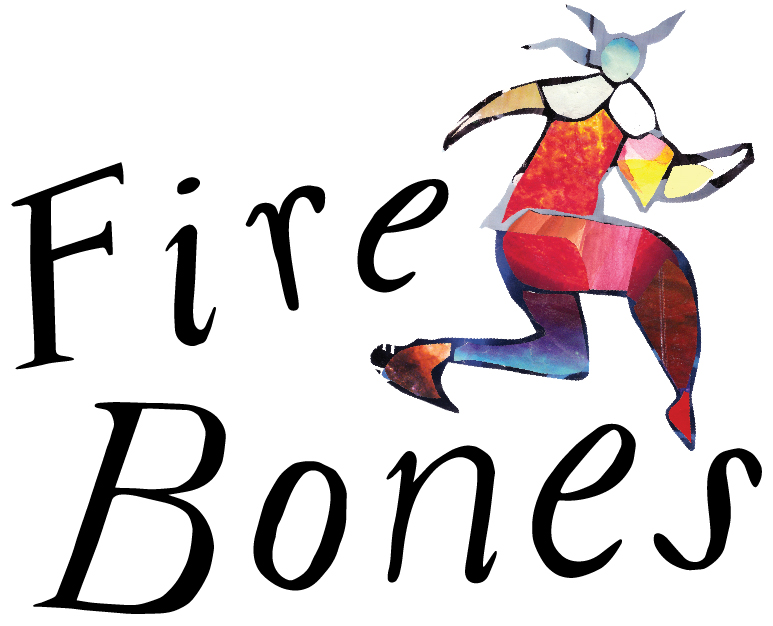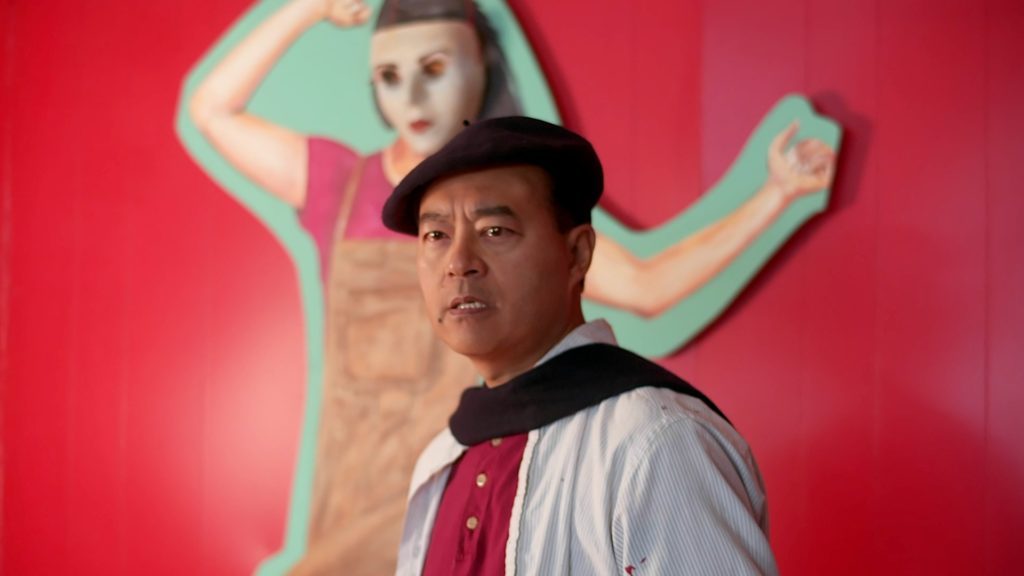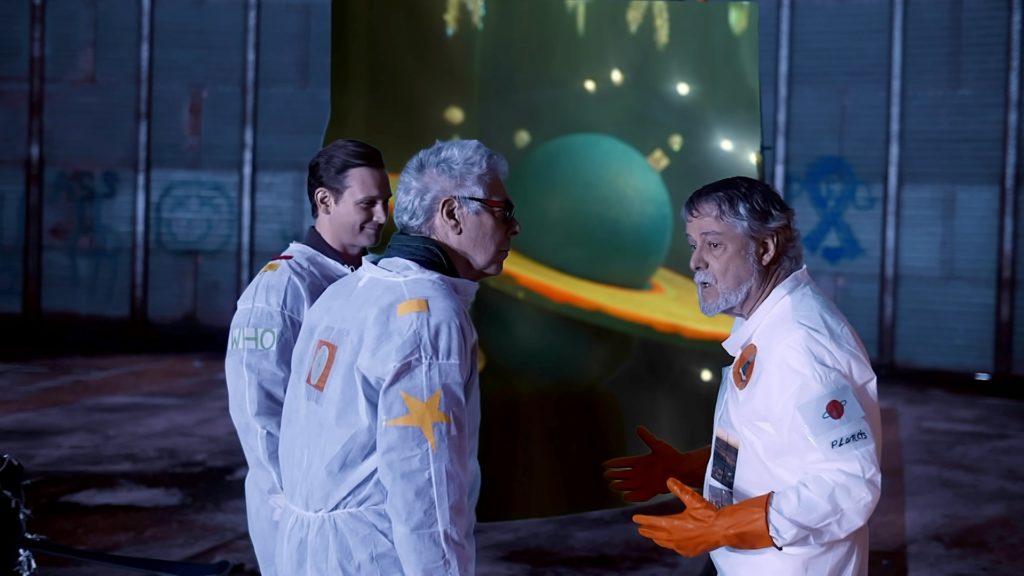
A Lebanese-American ferry pilot. A Chinese-American grocer. A Midwestern-born misfit with a gift for gab. A self-styled provocateur and his salon of associates.
They are among the many small-town eccentrics you meet in Fire Bones, a new multimedia series from the mind of poet Greg Brownderville. He describes the format of the series as “the world’s first-ever go-show.” Part film, part podcast, part musical performance, it’s a daring, genre-defying work of fiction designed specifically for your smartphone. If all this sounds overly conceptual, the story itself is anything but. Imagine a formally inventive take on Twin Peaks or True Detective, and you start to get the picture.
Fire Bones sends poet Greg Brownderville and filmmaker Bart Weiss—or their fictional doubles, rather—on a quest through the Arkansas Delta, hoping to taste the region’s famous homemade ice cream. Along the way they get caught up in the mystery surrounding a snake-handling preacher who pilots crop dusters across the Atlantic. Amra Boustani’s disappearance sets up a series of interviews with local residents, each with a different theory about what happened to her. Gradually, things become more surreal and less concerned with the mystery the two heroes are supposedly trying to solve. The result is a many-sided narrative with a range of tones—comic, absurd, nightmarish—and a glorious mix of high and low pleasures.
Full disclosure: Greg and I met in grad school at the University of Mississippi, and we’ve been friends ever since. Already a published poet and folklorist, he would go on to write two notable books of poetry, Gust and A Horse with Holes in It. But for all his creative energy, I had my doubts about whether he was capable of pulling off something this audacious. Boy, was I wrong. Fire Bones delivers on so many levels. The production value is sky high; the soundscapes are lusciously arranged; the interface is stylish and straightforward. All of which makes for a thoroughly bingeable experience. Now that Fire Bones is out in the world, I asked him to talk more about how it all came together.
Let’s start with the idea of the go-show itself. Can you talk a little bit about how you decided to combine all these different forms of storytelling?
Everyone says constraints are generative, and I feel that, but there are serious downsides to containing a story in any single art form. Sometimes when I’m scribbling away on a poem, I find myself thinking, This image really just wants to be a photograph. Why am I insisting on words? Or I’ll start out writing a song and then realize it wants to be a poem, or vice versa, so I’ll switch art forms. One day the thought occurred to me: What if I really went all the way with this concept and let every moment of a story take shape in whatever art form suited it best? That idea turned into the go-show form.
You wrote and recorded most of the music for the series yourself. Each podcast opens with a traditional folk song and closes with a catchy pop song. There are music videos and various other original songs sprinkled throughout the episodes. What were you aiming for in terms of the sound of the score?
I just wanted to write a good record that would plumb the story’s core obsessions. I kept coming back to a character named Ju Mon Poy, the son of a prosperous Chinese grocer/restaurateur in the Delta. In 1995, when Ju Mon is twenty-seven, he briefly dates a Lebanese-American woman named Amra, and it’s the only time in his whole life he’s ever truly happy. When we meet Ju Mon in Fire Bones, he’s much older—fifty-something—but inside the antebellum mansion where he lives, he’s always twenty-seven and it’s always 1995. He curates this fake life in which Amra is still his girlfriend. The TV shows he watches, the calendar on the wall, the magazines in his living room, his clothing: it’s all from 1995. And the way he talks is totally absurd—he’s got this posh Rhett Butler accent, but he throws in 90s slang like “outtie 5000.” His one brief moment of happiness with Amra has become a prison of pain he can’t escape from.
As a songwriter, I was drawn to Ju Mon’s emotional predicament. You can hear his agony in the songs, but it’s often transmitted through colorful, comic lyrics and sounds. In one song, called “Ninety-Five,” Ju Mon’s missing Amra and thinking about how she used to garden naked in his backyard back in the day. The song starts out, “A nudist and a Buddhist walk into forever.” It’s like the setup for a joke, but the next lyric is “Don’t expect a punch line.” My collaborator Spencer Kenney did a masterful job of conjuring sounds to match the emotional complexity, and we represented it visually too. There’s a music video in the go-show where Ju Mon’s inside an art museum, prancing around, imitating the handsome heroes in the paintings. He thinks he’ll find the right pose to make Amra love him.

The story is set in the fictional town of Thisaway, Arkansas. There’s a long tradition of sprawling sagas set in small Southern towns, with Faulkner’s Yoknapatawpha series being the most, well, the most. But the local here is connected to the global in a way that feels entirely new. Do you see Fire Bones as breaking the mold?
The whole idea of localness in Fire Bones is pretty tricky. You’ve got this remote little town called Thisaway, but if you stay awhile—just ask me and Bart—you realize it’s secretly modded out with trap doors. Fall in, and next thing you know, you’re not in Ar(kansas) anymore.
Take the character Beall. She grew up in Honduras as a so-called “Confederada.” Her ancestors were big farmers from Thisaway who moved to Latin America after the Civil War. Beall is fictional, but that historical context is real: thousands of Confederates emigrated to Brazil and Honduras in the mid-1860s and tried to keep the bad old days of Dixie going. In some ways Beall is pure Thisaway: she’s got the accent, the mannerisms, the family history. It’s not altogether wrong to call her a Southern belle. But bizarrely enough, when she comes to Thisaway and locates her forebears’ antebellum mansion, it’s her first time setting foot in the Delta.
You could say Fire Bones is set in Thisaway, or you could say the real setting is the Internet, or your phone. The subplot involving Boulos, the boy YouTuber, helps to illustrate this point. Boulos lives in Lebanon, but thanks to social media and gossipy Internet comment sections, he more or less becomes part of Thisaway. He wears this suit jacket that’s probably his dad’s and acts like a cross between a loudmouth cable news host and a hard-driving investigative reporter. Before you know it, he and the Delta folks start bickering online.
The Internet is definitely one of those trap doors I’m talking about. This is why I think digital art is important: if we’re all gonna be online so much, we’ve got to take control of that space and stock it with material that’s worthy of our attention.
The narrative hook involves a Lebanese-American pilot whose plane goes missing in the Middle East. How did this premise come to you?
The Amra plotline, with its geopolitical scope, is like a Deep South twist on Homeland or 24. It’s pretty much the last thing you’d expect in combination with all the absurdist comedy and surrealism in this series. But like life in any era, especially ours, Fire Bones is all about crazy combos.
And one of those crazy combos is exactly what I mentioned before: the blurring of the local into the global. Here we’ve got this crop duster, which makes you expect a big blue country sky and a quiet cotton field, but no: in Fire Bones, the Delta crop duster’s buzzing around in war-torn Syria of all places. The pilot is actually the woman Ju Mon’s obsessed with—she does ferry flights from the US to the Middle East for an aircraft manufacturer. Which is a real job, it turns out. In one of the podcast episodes, I interview an actual ferry pilot who flies American-made crop dusters to overseas buyers.
Fire Bones is also a story about immigrants. Amra Boustani comes from a Lebanese family and preaches at the Pentecostal church. Ju Mon Poy descends from Chinese immigrants and lives in an antebellum home. What is their place in the setting you’ve chosen, specifically as it relates to the traditional culture of the South?
I can’t even imagine the Delta without immigrants and their stories. Amra’s family makes for a good example. Her grandpa is a Lebanese Catholic who comes to the Delta to enjoy religious freedom and make a living as a peddler. The subtropical climate was attractive to peddlers because they often had to sleep outdoors. When Amra’s just a little girl, she wants to preach the gospel, so she strikes up a door-to-door ministry, working her grandpa’s peddling route for Jesus. She’s culturally Catholic but spiritually Pentecostal. I got this idea from talking to a Lebanese man I know in Mississippi. His name is Pat Davis, and like Amra, he’s a Maronite Catholic who embraces “charismatic” worship practices. Last time I saw Pat, we met up at Abe’s, the BBQ restaurant he owns in Clarksdale, Mississippi. The special of the day was pulled pork with a side of stuffed grape leaves. This kind of thing shows up in my writing because it’s the South as I know it.

One scene early on follows the two main characters—the fictional Greg and Bart—inside a grain silo that turns into a spaceship and blasts off to another planet. Their destination is Planet Swan—a bizarro version of the Arkansas Delta. What made you decide to inject elements of science fiction, and how do you see this theme fitting into the larger story you’re telling?
Writing and shooting that Silo Spaceship scene, I had more fun than any man ought. It’s Bart’s first time in the Delta, so we stop at the welcome center. He’s expecting brochures and bad coffee, but instead it’s a giant silver silo presided over by a man they call The Beekeeper Spaceman. (Personally, I’ve always thought beekeepers look like astronauts—the white suits, the headgear.) The Beekeeper Spaceman insists we wear these ridiculous puffy white suits like he’s got on. After we situate ourselves inside the silo, he launches us into outer space. Then faux tragedy strikes! He tells us there’s been “a despicable malfunction with [his] rig” and that he’ll have to park it on a secret planet known as Swan. Of course, this is all in his head. At least we think so anyway—it’s hard to tell.
Here equals there, thisaway is thataway, and home’s the place that never stops surprising. That’s how the Delta feels to me. I ran across the phrase “strange at home” in a book a long time ago. The author—I believe it was Harold Bloom, but don’t quote me on that—he was saying that great literature makes him feel “strange at home.” I remember thinking, “I don’t need literature for that. I’ve always felt strange at home.” Certainly the Delta seems next-level weird to outsiders—that’s to be expected—but it often strikes its own natives as bizarre. You’d think familiarity would attenuate that perception. Nope. And I for one am thankful.
Some of the most arresting images remind me of the photographs of William Eggleston. Like Eggleston, you and cinematographer Christian Vasquez manage to capture the strange beauty of a place known mostly for its extreme poverty. As a Delta native, have you always been attuned to the region’s hidden face? Did you have in mind a general area you wanted to film or did you and the crew scout for locations?
I had super specific locations and images in mind. Like, in Cotton Plant there’s this one house with homemade zebra sculptures flanking the drive. I knew I wanted to film a scene right there. Close to a town called Hillemann, there’s a rusty yellow grain auger. Because of its shape and the way the patches of rust are coming in, it looks like a giraffe. I knew I wanted to film a little boy wearing a giraffe hat and climbing around on that auger. I made a couple trips back to the Delta alone to make sure the things I remembered were still there, and for the most part they were.
There’s a connection between the region’s extreme poverty and its artistic flair. Creativity is not really optional when you’re dealing with that level of bleakness and desolation. You need some beauty or mischief to survive. That’s why the Delta’s full of homemade signs and brightly colored buildings and imaginative folk art. Fire Bones taps into that aesthetic through Kaila Rose Parrish’s collages on the website and the art direction in general.
This is true of the characters as well, who are always looking for ways to liven up the scene. There’s a character named Chad Fonda who moves into a defunct church and starts putting bizarre little messages on the sign out front. Stuff like “Bunny poop found on local roadsides” and “Bad weather makes me horny.” Fonda also takes a job as the high school cheerleading coach and has his proteges yelling Dadaist cheer slogans: Reimagine the Lions! Ignore the Kangaroos! Jiggle the Hermits!
Much of the show’s pleasure comes from its weirdness, not to mention a hefty dose of humor. So tell me about balancing the different tones while also trying to weave it all into a cohesive whole.
I’ve always been drawn to warped forms, which is why I love visual artists like Mose Tolliver and Samiro Yunoki. That kind of weirdness is born funny—the comedy is native to the oddity.
Talking about this reminds me of something I haven’t thought about in years: one day when I was a little kid, I went out to the dump with my dad, and you’d have thought some junkyard Dali had been sneaking around out there, messing with stuff. For example, I found a glass coke bottle all melty in the sun like a surrealist sculpture. Even a plain old dirty bottle could warp into something wondrous-weird. To steal a line from Chad Fonda’s church sign, “Anything’s possible out here, pumpkin.”
Follow Vol. 1 Brooklyn on Twitter, Facebook, and sign up for our mailing list.
